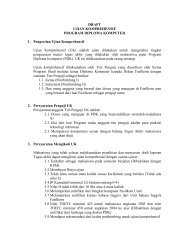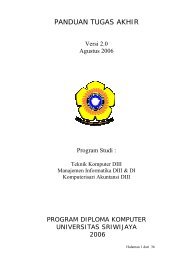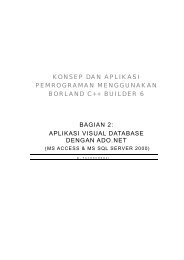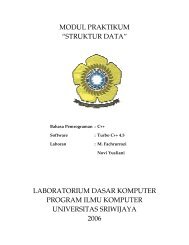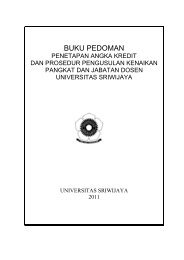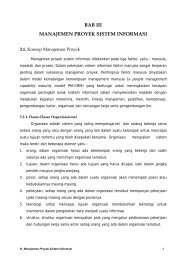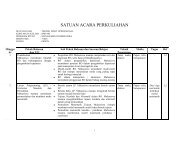Changes in zooxanthellae density, morphology, and mitotic index in ...
Changes in zooxanthellae density, morphology, and mitotic index in ...
Changes in zooxanthellae density, morphology, and mitotic index in ...
Create successful ePaper yourself
Turn your PDF publications into a flip-book with our unique Google optimized e-Paper software.
574 J.M. Cerv<strong>in</strong>o et al. / Mar<strong>in</strong>e Pollution Bullet<strong>in</strong> 46 (2003) 573–586<br />
Fig. 1. Photo of a cyanide fisherman squirt<strong>in</strong>g cyanide from a squirt<br />
bottle to capture fish.<br />
mak<strong>in</strong>g it difficult to determ<strong>in</strong>e the cyanide ion (CN )<br />
concentrations be<strong>in</strong>g applied. It has been suggested that<br />
fish collectors use concentrations rang<strong>in</strong>g from 1500 to<br />
120,000 mg/l (Johannes <strong>and</strong> Riepen, 1995; Barber <strong>and</strong><br />
Pratt, 1998; Pet <strong>and</strong> Djohani, 1998; Jones et al., 1998).<br />
S<strong>in</strong>ce not all of the cyanide applied from squirt bottles<br />
dissolves, it is sometimes visible underwater as a whitish<br />
plume (Rubec et al., 2001). Not all fishermen limit<br />
themselves to squirt bottles. Reports from the Philipp<strong>in</strong>es<br />
assert that 55-gallon drums of cyanide have been<br />
dumped onto reefs to kill <strong>and</strong> capture food fish (del<br />
Norte et al., 1989; Johannes <strong>and</strong> Riepen, 1995).<br />
The various forms of cyanide fish<strong>in</strong>g contribute to<br />
degraded, lifeless coral reefs (Rubec, 1986; Johannes <strong>and</strong><br />
Riepen, 1995; Barber <strong>and</strong> Pratt, 1998) <strong>and</strong> force fishermen<br />
to relocate to more prist<strong>in</strong>e locations. Unfortunately,<br />
fishermen usually br<strong>in</strong>g cyanide techniques with<br />
them, thus repeat<strong>in</strong>g the cycle of destruction of the coral<br />
reefs <strong>and</strong> associated fish communities.<br />
Although illegal <strong>in</strong> most Southeast Asian countries,<br />
cyanide fish<strong>in</strong>g is widespread <strong>and</strong> is be<strong>in</strong>g <strong>in</strong>troduced to<br />
other regions (Johannes <strong>and</strong> Riepen, 1995; Barber <strong>and</strong><br />
Pratt, 1997).<br />
Fishermen <strong>in</strong> the Philipp<strong>in</strong>es, Indonesia, Malaysia,<br />
Vietnam, <strong>and</strong> Papua New Gu<strong>in</strong>ea have reported cyanide<br />
use (Rubec, 1986; Johannes <strong>and</strong> Riepen, 1995; Barber<br />
<strong>and</strong> Pratt, 1998). Squirt<strong>in</strong>g cyanide onto a reef is an easy<br />
way to force fish out of coral crevices. Stressed <strong>and</strong><br />
poisioned, they swim to open-water areas, where they<br />
are then captured. Although some fishermen acknowledge<br />
that cyanide fish<strong>in</strong>g kills corals, others deny that<br />
such damage occurs (Galvez et al., 1989; H<strong>in</strong>gco <strong>and</strong><br />
Rivera, 1991).<br />
In a field visit to devastated reefs <strong>in</strong> the Philipp<strong>in</strong>es,<br />
former cyanide fishermen showed the author <strong>in</strong>dividual<br />
coral heads that had died follow<strong>in</strong>g one application of<br />
cyanide (Cerv<strong>in</strong>o <strong>and</strong> Goreau, personal observation).<br />
Furthermore, an unpublished study by the Philipp<strong>in</strong>e<br />
Bureau of Fisheries <strong>and</strong> Aquatic Resources found that<br />
corals situated on test quadrants off Mactan Isl<strong>and</strong> near<br />
Cebudied after two applications of CN spaced 4<br />
months apart (Rubec, 1986, 1997).<br />
There have been several studies regard<strong>in</strong>g the deleterious<br />
effect of cyanide exposure to corals. Dr. Robert<br />
Richmond of the University of Guam found that Pocillopora<br />
damicornis colonies exposed to 4000 mg/l CN<br />
for 10 m<strong>in</strong> began to bleach with<strong>in</strong> 4 days (Johannes <strong>and</strong><br />
Riepen, 1995). N<strong>in</strong>e out of 10 Pocillopora specimens<br />
died with<strong>in</strong> 4 days. When exposed to CN concentrations<br />
of 100 mg/l for 30 m<strong>in</strong>, Pocillopora specimens<br />
bleached with<strong>in</strong> 3–4 days <strong>and</strong> tissue loss began after 9<br />
days. Likewise, Pocillopora damicornis <strong>and</strong> Porites lichen<br />
were exposed to a 5200 mg/l CN concentration caused<br />
100% mortality (Jones, 1997; Jones <strong>and</strong> Steven, 1997)<br />
with exposure times of 10, 20, or 30 m<strong>in</strong>. Tissues coat<strong>in</strong>g<br />
the skeletons of Pocillopora damicornis sloughed off<br />
with<strong>in</strong> 24 h. Porites lichen colonies became covered with<br />
a thick mucus-like tunic. After 7 days, the tunics of all<br />
the Porites colonies lifted off, leav<strong>in</strong>g bare skeletons.<br />
Shorter exposure times (1 or 5 m<strong>in</strong>) <strong>and</strong> lower CN<br />
concentrations (52 or 520 mg/l) <strong>in</strong>duced bleach<strong>in</strong>g (loss<br />
of pigment) <strong>in</strong> both coral species with<strong>in</strong> 7 days (Jones<br />
<strong>and</strong> Steven, 1997).<br />
Cyanide was also shown to <strong>in</strong>hibit photosynthesis<br />
<strong>and</strong> calcification rates of Acropora formosa <strong>and</strong> Acropora<br />
cervicornis <strong>in</strong> corals exposed to concentrations of 5<br />
mg/l (Chalker <strong>and</strong> Taylor, 1975). Photosynthesis <strong>and</strong><br />
calcification were not <strong>in</strong>hibited at the highest concentration<br />
tested (5 mg/l), suggest<strong>in</strong>g the existence of cyanide-resistant<br />
respiration <strong>in</strong> either the <strong>zooxanthellae</strong> or<br />
the host (Barnes, 1985). Research by Jones et al. (1998)<br />
showed that photo-<strong>in</strong>hibition from exposure to cyanide<br />
resulted <strong>in</strong> an almost complete cessation of photosynthetic<br />
electron transport from algae <strong>in</strong> tissues of Stylophora<br />
pistillata <strong>and</strong> Acropora aspera. Cyanide was<br />
applied to small branch tips of these species at concentrations<br />
estimated to occur dur<strong>in</strong>g cyanide fish<strong>in</strong>g.<br />
Pulse-amplitude-modulation (PAM) chlorophyll fluorescence<br />
was used to exam<strong>in</strong>e photo-<strong>in</strong>hibition <strong>and</strong><br />
photosynthetic electron transport <strong>in</strong> the symbiotic algae<br />
(<strong>zooxanthellae</strong> <strong>in</strong> the tissues of the corals). Jones <strong>and</strong><br />
Hoegh-Guldberg (1999) have suggested that cyanide<br />
acts as an <strong>in</strong>hibitor of the dark reactions of the Calv<strong>in</strong><br />
cycle; specifically, as an <strong>in</strong>hibitor of ribulose-1,5-biphosphate<br />
carboxylase/oxygenase.<br />
No known studies have been published <strong>in</strong>vestigat<strong>in</strong>g<br />
the direct effects on cyanide on symbiotic algae, the<br />
focus of this paper. Related work by Dr. R. Richmond<br />
<strong>in</strong>dicated that m<strong>in</strong>or concentrations of cyanide can have<br />
a deleterious effect on the relationship between symbiotic<br />
algae <strong>and</strong> host tissue <strong>in</strong> cnidarians, result<strong>in</strong>g <strong>in</strong><br />
death. But RichmondÕs <strong>in</strong> vitro experiment was limited<br />
to film<strong>in</strong>g the expulsion <strong>and</strong> behavior of <strong>zooxanthellae</strong><br />
from corals follow<strong>in</strong>g cyanide exposure (personal communication,<br />
1999).



